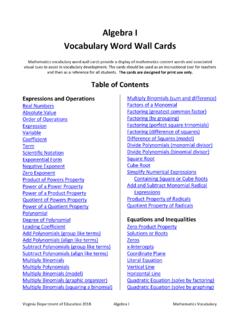Transcription of Using Graphs and Charts to Illustrate No. 12 | updated ...
1 November 21, 2018C296013-HEvaluation BriefsUsing Graphs and Charts to Illustrate Quantitative DataNo. 12 | updated August 2018 Using visual representations to present data from Indicators for School Health, (SLIMS), surveys, or other evaluation activities makes them easier to understand. Bar Graphs , pie Charts , line Graphs , and histograms are an excellent way to Illustrate your program results. This brief includes concepts and definitions, types of Graphs and Charts , and guidelines for Concepts and DefinitionsGraphs and Charts condense large amounts of information into easy-to-understand formats that clearly and effectively communicate important points.
2 In selecting how best to present your data, think about the purpose of your graph or chart and what you want to present, then decide which variables you want to include and whether they should be expressed as frequencies, percentages, or you decide what kind of graph or chart best illustrates your data, you should consider what type of data you are working with. Categorical data are grouped into non-overlapping categories (such as grade, race, and yes or no responses). Bar Graphs , line Graphs , and pie Charts are useful for displaying categorical data. Continuous data are measured on a scale or continuum (such as weight or test scores). Histograms are useful for displaying continuous Graphs , line Graphs , and histograms have an x- and y-axis.
3 The x-axis is the horizontal part of the graph and the y-axis is the vertical of Graphs and Charts A bar graph is composed of discrete bars that represent different categories of data. The length or height of the bar is equal to the quantity within that category of data. Bar Graphs are best used to compare values across categories. A pie chart is a circular chart used to compare parts of the whole. It is divided into sectors that are equal in size to the quantity represented. A line graph displays the relationship between two types of information, such as number of school personnel trained by year. They are useful in illustrating trends over time.
4 A histogram has connected bars that display the frequency or proportion of cases that fall within defined intervals or columns. The bars on the histogram can be of varying width and typically display continuous for Formatting Graphs and Charts Keep it simple and avoid flashy special effects. Present only essential information. Avoid Using gratuitous options in graphical software programs, such as three-dimensional bars, that confuse the reader. If the graph or chart is too complex, it will not clearly communicate the important points. Title your graph or chart clearly to convey the purpose. The title provides the reader with the overall message you are conveying.
5 Specify the units of measurement on the x- and y-axis. Years, number of participants trained, and type of school personnel are examples of labels for units of measurement. Label each part of the chart or graph . You may need a legend if there is too much information to label each part of the chart or graph . (See the line graph ). Use different colors or variations in patterns to help the reader distinguish categories and understand your graph or E, Michaud M. Using Graphics to Report Evaluation Results. University of Wisconsin Cooperative Extension. at Evaluation Briefs #12. Using Graphs and Charts to Illustrate Quantitative Data. Available at: For further information or assistance, contact the Evaluation Research Team at You can also contact us via our website.












